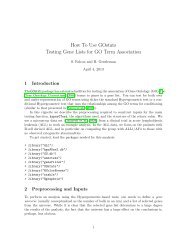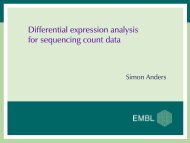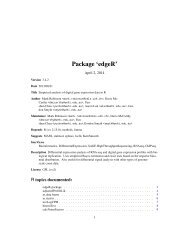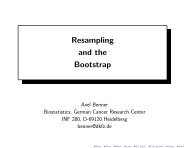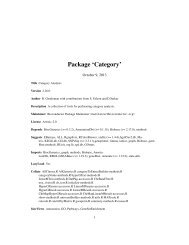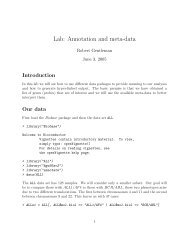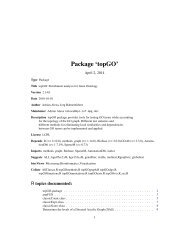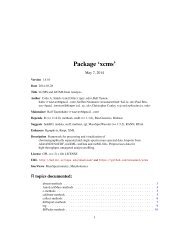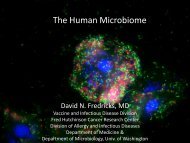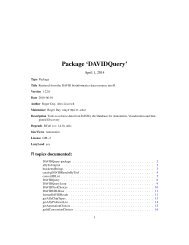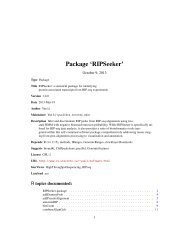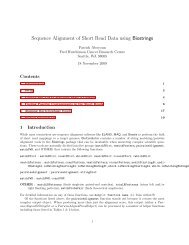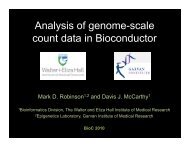Genetics of gene expression: 2010 lab - Bioconductor
Genetics of gene expression: 2010 lab - Bioconductor
Genetics of gene expression: 2010 lab - Bioconductor
Create successful ePaper yourself
Turn your PDF publications into a flip-book with our unique Google optimized e-Paper software.
<strong>Genetics</strong> <strong>of</strong> <strong>gene</strong> <strong>expression</strong>: <strong>2010</strong> <strong>lab</strong>VJ CareyJuly 28, <strong>2010</strong>Contents1 eQTL concepts and discovery tools 21.1 Checking for informative variants for a specified <strong>gene</strong> . . . . . . . . . . . 31.2 Components <strong>of</strong> the workflow; refinements . . . . . . . . . . . . . . . . . . 41.2.1 Data representation: smlSet . . . . . . . . . . . . . . . . . . . . . 61.2.2 Analysis: snp.rhs.tests; permutation testing . . . . . . . . . . . 81.2.3 Context: GenomicRanges and rtracklayer . . . . . . . . . . . . . 92 Comprehensive eQTL surveys: performance issues 112.1 A study <strong>of</strong> <strong>gene</strong>s coresident on chromosome 20 . . . . . . . . . . . . . . . 112.2 Expanding to <strong>gene</strong>s on multiple chromosomes . . . . . . . . . . . . . . . 132.3 Exercises . . . . . . . . . . . . . . . . . . . . . . . . . . . . . . . . . . . . 153 Investigating allele-specific <strong>expression</strong> with RNA-seq data 173.1 The data . . . . . . . . . . . . . . . . . . . . . . . . . . . . . . . . . . . . 173.2 Filtering to “coding SNP”; checking for de novo variants . . . . . . . . . . 183.3 Assessing allelic imbalance in transcripts harboring SNPs . . . . . . . . . 203.4 Checking consistency <strong>of</strong> findings with GENEVAR <strong>expression</strong> arrays . . . 233.5 Exercises . . . . . . . . . . . . . . . . . . . . . . . . . . . . . . . . . . . . 244 Appendix: samtools pileup format, from samtools distribution site 255 Session information 261
Figure 1: A schematic illustrating various nonexclusive mechanisms by which DNAvariants can affect transcript abundance (Williams et al., 2007).1 eQTL concepts and discovery toolsThe basic concern in the <strong>lab</strong> is the relationship between structural variation in DNA andvariation in mRNA abundance. DNA variants <strong>of</strong> interest are primarily SNP as identifiedthrough• direct genotyping in the Sanger sequencing paradigm (yielding HapMap phase IIgenotypes, for example)• array-based genotyping (yielding HapMap phase III)• NGS-based variant calling (as provided for 1000 genomes (1KG))• hybrids <strong>of</strong> array-based and imputed genotypes (imputation to the 1KG panel)mRNA variation is typically characterized using <strong>gene</strong> <strong>expression</strong> microarrays, but RNAseqcan also be considered.A helpful schematic indicating possible impacts <strong>of</strong> structural variation on <strong>gene</strong> transcriptionis given in Williams et al. (2007); see Figure 1.2
To elucidate impacts <strong>of</strong> DNA variations on regulation <strong>of</strong> <strong>gene</strong> transcription we needto be able to• represent mRNA abundance and SNP genotypes (both observed and imputed) ina coordinated way for many samples• perform suitably focused and calibrated tests <strong>of</strong> association between mRNA levelsand genotype (e.g., allele count for a SNP)• provide significance assessments and functional contexts for observed associations.On the basis <strong>of</strong> excellent algorithms and s<strong>of</strong>tware in the snpMatrix package <strong>of</strong> Claytonand Leung (Clayton and Leung, 2007)), the GGtools package provides tools to addressall <strong>of</strong> these concerns.1.1 Checking for informative variants for a specified <strong>gene</strong>The following is a simple illustration <strong>of</strong> a focused workflow.> library(GGtools)Loading package ff 2.1-2- getOption("fftempdir")=="/var/folders/4D/4DI98FkjGzq0K2niUTEHSE+++TM/-Tmp-//RtmpLbQBu- getOption("ffextension")=="ff"- getOption("ffdrop")==TRUE- getOption("fffinonexit")==TRUE- getOption("ffpagesize")==65536- getOption("ffcaching")=="mmn<strong>of</strong>lush" -- consider "ffeachflush" if your system stalls- getOption("ffbatchbytes")==16777216 -- consider a different value for tuning your sysAttaching package ff> if (!exists("hmceuB36.2021")) data(hmceuB36.2021)> f1 = gwSnpTests(<strong>gene</strong>sym("CPNE1") ~ male, hmceuB36.2021, chrnum(20))> topSnps(f1)p.valrs17093026 6.485612e-14rs1118233 1.897898e-13rs2425078 2.426168e-13rs1970357 2.426168e-13rs12480408 2.426168e-13rs6060535 2.426168e-13rs11696527 2.426168e-13rs6058303 2.426168e-13rs6060578 2.426168e-13rs7273815 2.544058e-133
These findings can be visualized in the context <strong>of</strong> the chromosome in a so-calledManhattan plot; see Figure 2.1.2 Components <strong>of</strong> the workflow; refinementsThe primary workhorse thus far is gwSnpTests. We need to understand its interface andits return values.> showMethods("gwSnpTests")Function: gwSnpTests (package GGtools)sym="formula", sms="smlSet", cnum="chrnum", cs="missing"(inherited from: sym="formula", sms="smlSet", cnum="cnumOrMissing", cs="missing")sym="formula", sms="smlSet", cnum="cnumOrMissing", cs="missing"sym="formula", sms="smlSet", cnum="snpdepth", cs="chunksize"sym="formula", sms="smlSet", cnum="snpdepth", cs="missing"> f1cwSnpScreenResult [chr 20 ] for <strong>gene</strong> CPNE1 [probe GI_23397697-A ]> class(f1)[1] "cwSnpScreenResult"attr(,"package")[1] "GGBase"> getClass(class(f1))Class "cwSnpScreenResult" [package "GGBase"]Slots:Name: .Data chrnum <strong>gene</strong> psid annotation testTypeClass: list chrnum character character character characterName:Class:call sessionInfocall SessionInfoExtends:Class "gwSnpScreenResult", directlyClass "list", by class "gwSnpScreenResult", distance 2Class "vector", by class "gwSnpScreenResult", distance 3Class "AssayData", by class "gwSnpScreenResult", distance 34
plot(f1)CPNE1●−log10 p Gaussian LM [1df]0 2 4 6 8 10 12● ●●●●●●●●●●●●●●● ●●●●●●●●●●●●●●●●●●●●●●●●●●●●●●●●●●●●●●●●●● ●●0e+00 1e+07 2e+07 3e+07 4e+07 5e+07 6e+07position on chr 20Figure 2: Manhattan plot for chromosome 20 eQTL for CPNE1. The y axis measuresthe significance <strong>of</strong> association <strong>of</strong> SNP allele copy number with <strong>expression</strong> for this <strong>gene</strong>.The association is measured by a χ 2 (1) statistic transformed to a p-value, which islogarithmically transformed and then multiplied by −10.5
1.2.1 Data representation: smlSetThe smlSet container provides coordinated management <strong>of</strong> <strong>expression</strong>, genotype, phenotype,and other metadata in a fashion broadly consistent with the ExpressionSetclass. If X is an smlSet instance then• exprs(X) and pData(X) have familiar roles <strong>of</strong> extracting a matrix <strong>of</strong> <strong>expression</strong>values, and a data.frame <strong>of</strong> sample-level data• X[,S] subsets the samples according to predicate S• X[probeId(P),] subsets the <strong>expression</strong> data to probes enumerated in predicate P• X[chrnum(C),] subsets the genotype data to chromosome C• annotation(X) returns the annotation package used for mapping <strong>expression</strong> probeidentifiersClearly there are two kinds <strong>of</strong> feature in use here: <strong>expression</strong> probes and SNPs. Theambiguous handling <strong>of</strong> the X[G,] idiom has not posed a problem thus far. As thestructure gains wider use, more features may be added to simplify filtering throughbracket-based operations.Operations targeted on the genotype data component include:• smList(X) returns a list <strong>of</strong> snp.matrix objects, using a byte to encode eachgenotype• MAFfilter(X,...) will remove SNP that fail to meet a minor allele frequencycriterion• GTFfilter(X,...) will remove SNP that fail to meet a minimum genotype frequencycriterionThe GGtools package provides hmceuB36.2021 as a modest-sized exemplar <strong>of</strong> thesmlSet structure, with HapMap phase II genotype data from chromosomes 20 and 21,and GENEVAR <strong>expression</strong> data for 90 CEU individuals.> hmceuB36.2021snp.matrix-based genotype set:number <strong>of</strong> samples: 90number <strong>of</strong> chromosomes present: 2annotation: illuminaHumanv1.dbExpression data dims: 47293 x 90Phenodata: An object <strong>of</strong> class "AnnotatedDataFrame"sampleNames: NA06985, NA06991, ..., NA12892 (90 total)6
varLabels and varMetadata description:famid: hapmap family idpersid: hapmap person id...: ...male: logical TRUE if male(7 total)> names(pData(hmceuB36.2021))[1] "famid" "persid" "mothid" "fathid" "sampid" "isFounder"[7] "male"> table(hmceuB36.2021$isFounder)FALSE TRUE30 60The <strong>expression</strong> data is managed exactly as in an ExpressionSet from Biobase. Thegenotype data has a concise representation. It and its coercions are defined in thesnpMatrix package.> s20 = smList(hmceuB36.2021)[["20"]]> s20A snp.matrix with 90 rows and 119921 columnsRow names: NA06985 ... NA12892Col names: rs4814683 ... rs6090120> as(s20, "matrix")[1:4,1:4] # show rawrs4814683 rs6076506 rs6139074 rs1418258NA06985 03 03 03 03NA06991 02 03 02 02NA06993 01 03 01 01NA06994 01 03 01 01> as(s20, "character")[1:4,1:4]rs4814683 rs6076506 rs6139074 rs1418258NA06985 "B/B" "B/B" "B/B" "B/B"NA06991 "A/B" "B/B" "A/B" "A/B"NA06993 "A/A" "B/B" "A/A" "A/A"NA06994 "A/A" "B/B" "A/A" "A/A"> as(s20, "numeric")[1:4,1:4]7
s4814683 rs6076506 rs6139074 rs1418258NA06985 2 2 2 2NA06991 1 2 1 1NA06993 0 2 0 0NA06994 0 2 0 0Question 1: Use plot_EvG to visualize the specific relationship between <strong>expression</strong>and allele copy number for the best result for CPNE1 shown above.Question 2: Create a new smlSet hmff limited to CEU founders and with genotypeshaving minimum genotype frequency at least 5%.Question 3: Test for eQTL for CPNE1 in the filtered structure, saving the resultin f1f for later conversions. Create relevant visualizations.1.2.2 Analysis: snp.rhs.tests; permutation testingThe snpMatrix package supplied various utilities for <strong>gene</strong>ral analysis <strong>of</strong> genome-wideassociation studies. gwSnpTests is just a wrapper for the snp.rhs.tests function. Tosee it in action,> SS = (SS class(SS)[1] "snp.tests.glm"attr(,"package")[1] "snpMatrix"> length(names(SS))[1] 119921> sum(is.na(p.value(SS)))[1] 53695> SS[1:4, ]Chi.squared Df p.valuers4814683 0.071165981 1 0.7896466rs6076506 0.002905309 1 0.9570141rs6139074 0.680486311 1 0.4094193rs1418258 0.077548726 1 0.7806472> SS["rs6060535", ]8
Chi.squared Df p.valuers6060535 53.62528 1 2.426168e-13This shows that for a given phenotypic response, large numbers <strong>of</strong> GWAS tests can beperformed rapidly.Question 4: Why do so many tests have p-value NA?Which <strong>of</strong> our findings are significant in the context <strong>of</strong> so many tests? We can permutethe <strong>expression</strong> data, keeping the genotype data fixed. Here is one way to obtain a samplefrom the permutation distribution <strong>of</strong> the smallest p-value for a specific <strong>gene</strong>.> Mtests = sapply(1:100, function(x) topSnps(gwSnpTests(<strong>gene</strong>sym("CPNE1") ~+ male, sms = permEx(hmceuB36.2021), cnum = chrnum(20)))[[1]][1])1.2.3 Context: GenomicRanges and rtracklayerA major response to the transition to high-throughput sequencing assays is the IRangesinfrastructure. The GenomicRanges package defines the GRanges class, to which we canconvert results <strong>of</strong> an eQTL search:> gr1 = as(f1, "GRanges")> gr1[1:4, ]GRanges with 4 ranges and 4 elementMetadata valuesseqnames ranges strand | type group score | rs4814683 chr20 [ 9795, 9795] * | snpeff gws 0.10256722rs6076506 chr20 [11231, 11231] * | snpeff gws 0.01908166rs6139074 chr20 [11244, 11244] * | snpeff gws 0.38783167rs1418258 chr20 [11799, 11799] * | snpeff gws 0.10754519universers4814683 hg18rs6076506 hg18rs6139074 hg18rs1418258 hg18seqlengthschr20NA> gr2 = as(f1f, "GRanges")Question 5: Export these GRanges instances as wig files and add to a UCSCbrowser session as custom tracks. You could do this with rtracklayer if your searchlisthad a particular form. You should see something like Figure 3; R Track 1 is the searchon all SNP; R Track 2 follows the restriction to minimum genotype frequency 5%.9
Figure 3: Browser tracks associated with eQTL screens f1 and f1f.10
2 Comprehensive eQTL surveys: performance issuesA comprehensive survey <strong>of</strong> eQTL would consider possible relationships between 20000or so <strong>gene</strong>s and 8 million or more SNP (the latter is the approximate size <strong>of</strong> the 1000genomes SNP panel). Creating, storing, and interrogating the family <strong>of</strong> 160 billion resultsis a significant undertaking. We now illustrate a strategy for conducting comprehensivesurveys.2.1 A study <strong>of</strong> <strong>gene</strong>s coresident on chromosome 20We will select 50 <strong>gene</strong>s at random from chromosome 20 and compute all tests for associationwith SNP on chromosome 20.First we select the <strong>gene</strong>s and filter the smlSet:> set.seed(1234)> library(illuminaHumanv1.db)> g20 = get("20", revmap(illuminaHumanv1CHR))> samp = sample(g20, size = 50, replace = FALSE)> hlit = hmceuB36.2021[probeId(samp), ]If you are using a POSIX-compliant system, you can speed up this process by distributingover cores. We will be writing data to a folder called dem50.> try(system("rm -rf dem50"))> if (try(require(multicore))) {+ unix.time(e1 unix.time(e1 e1eqtlTools results manager, computed Wed Jul 28 06:50:49 <strong>2010</strong>There are 2 chromosomes analyzed.some <strong>gene</strong>s: GI_26051259-I GI_42734342-S ... hmm26595-S GI_24041039-Asome snps: rs4814683 rs6076506 ... rs6062370 rs609012011
class(e1)[1] "eqtlTestsManager"attr(,"package")[1] "GGtools"> getClass(class(e1))Class "eqtlTestsManager" [package "GGtools"]Slots:Name: fflist call sess exdate shortfac <strong>gene</strong>anno dfClass: list call ANY ANY numeric character numericWe are using the ff package to use disk to maintain extremely voluminous outputs.> e1@fflist[[1]][1:4, 1:4]GI_26051259-I GI_42734342-S GI_29570787-I GI_42662261-Srs4814683 86 7 15 1rs6076506 183 71 0 41rs6139074 68 39 1 23rs1418258 101 6 23 1> e1@shortfac[1] 100The information shown above is not intended for public consumption. Instead we performfocused interrogation using brackets and casting:> e1[rsid("rs4814683"), probeId("GI_26051259-I")]$`20`GI_26051259-Irs4814683 0.86Typical use case: finding a collection <strong>of</strong> strongest associations:> topFeats(probeid = "GI_26051259-I", mgr = e1, ffind = 1, anno = "illuminaHumanv1.db"rs708954 rs237422 rs6017409 rs6065590 rs6107778 rs6030278 rs6120934 rs613969218.56 18.25 16.42 16.06 15.95 15.63 15.56 15.41rs6031075 rs604929914.79 14.6612
topFeats(rsid = "rs708954", mgr = e1, ffind = 1, anno = "illuminaHumanv1.db")KCNQ2 THBD ATRN SRC NFS1 TP53INP2 PFDN4 EMILIN318.56 6.97 5.13 4.13 3.20 2.99 2.86 2.74TCF15 CST22.39 2.19> topFeats(sym = "SRC", mgr = e1, ffind = 1, anno = "illuminaHumanv1.db")rs6063909 rs293554 rs293558 rs293559 rs293544 rs293543 rs293553 rs614131923.88 18.09 18.09 18.09 17.42 17.31 17.28 16.84rs1022732 rs491124216.84 16.842.2 Expanding to <strong>gene</strong>s on multiple chromosomesThe analysis conducted just above uses <strong>gene</strong>s on chromosome 20. We repeat with some<strong>gene</strong>s on chromosome 21. First sample the <strong>gene</strong>s:> g21 = get("21", revmap(illuminaHumanv1CHR))> samp21 = sample(g21, size = 50, replace = FALSE)> hlit21 = hmceuB36.2021[probeId(samp21), ]Now perform the tests, using a different target folder:> try(system("rm -rf dem50.21"))> unix.time(e2 e2eqtlTools results manager, computed Wed Jul 28 06:51:13 <strong>2010</strong>There are 2 chromosomes analyzed.some <strong>gene</strong>s: GI_20357564-S GI_21536427-S ... GI_21040313-I GI_31342650-Ssome snps: rs4814683 rs6076506 ... rs6062370 rs6090120To facilitate interrogation <strong>of</strong> the two sets <strong>of</strong> results simultaneously, the eqtlTestsManagerinstances need to be coordinated by a cisTransDirector instance.> try(system("rm -rf d2021_probetab.ff"))> try(system("rm -rf d2021_snptab.ff"))> d1 = mkCisTransDirector(list(e1, e2), "d2021", "snptab", "probetab",+ "illuminaHumanv1.db")> d113
eqtlTools cisTransDirector instance.there are 2 managers.Total number <strong>of</strong> SNP: 170086 ; total number <strong>of</strong> <strong>gene</strong>s: 100First:eqtlTools results manager, computed Wed Jul 28 06:50:49 <strong>2010</strong>There are 2 chromosomes analyzed.some <strong>gene</strong>s: GI_26051259-I GI_42734342-S ... hmm26595-S GI_24041039-Asome snps: rs4814683 rs6076506 ... rs6062370 rs6090120---use [ (rsnumvec), (<strong>gene</strong>idvec) ] to obtain chisq stats; topFeats(), etc.> d1["rs6090120", "GI_42734342-S"]GI_42734342-Srs6090120 0You are now managing and interrogating 170 million test results. By increasing thenumbers <strong>of</strong> <strong>gene</strong>s and SNP held in the smlSet instances passed to eqtlTests you canincrease this. Interfaces need further refinement.14
3 Investigating allele-specific <strong>expression</strong> with RNAseqdataWe consider a study <strong>of</strong> read mapping bias in RNA-seq (Degner et al., 2009). We willconsider how to identify SNPs located in exons, how to analyze allele frequencies for suchSNP, and how to check findings against existing sequencing data and eQTL statisticsfor a single individual and a HapMap population.3.1 The dataWe will use a samtools pileup representation <strong>of</strong> RNA-seq data that were aligned usingMAQ and distributed by Degner and colleagues through GEO. We confine attention tochromosome 6 for individual NA19238, and use the “unmasked” alignment files. Datafrom two sequencing runs was combined using samtools merge, and then the pileup was<strong>gene</strong>rated against hg18.> library(GGtools)> library(Rsamtools)> pup238_6 = readPileup(system.file("pup/combn238_chr6.pup", package = "GGtools"),+ variant = "SNP")> pup238_6[1:4, ]GRanges with 4 ranges and 6 elementMetadata valuesseqnames ranges strand | referenceBase consensusBase | [1] chr6 [40376, 40376] * | C A[2] chr6 [43893, 43893] * | A C[3] chr6 [84124, 84124] * | T C[4] chr6 [84125, 84125] * | G AconsensusQuality snpQuality maxMappingQuality coverage [1] 4 4 0 1[2] 4 4 0 1[3] 4 4 0 1[4] 4 4 0 1seqlengthschr6NAIt will be useful to have the specific pileup <strong>of</strong> calls as well.> getPupCalls = function(pupfn) {+ tmp = strsplit(readLines(pupfn), "\t")17
+ sapply(tmp, "[", 9)+ }> callp = getPupCalls(system.file("pup/combn238_chr6.pup", package = "GGtools"))> elementMetadata(pup238_6)$callp = callp> pup238_6[144:148, ]GRanges with 5 ranges and 7 elementMetadata valuesseqnamesranges strand | referenceBase consensusBase | [1] chr6 [249623, 249623] * | C A[2] chr6 [249625, 249625] * | T A[3] chr6 [249662, 249662] * | G A[4] chr6 [256482, 256482] * | C T[5] chr6 [256873, 256873] * | C TconsensusQuality snpQuality maxMappingQuality coverage callp [1] 25 25 27 3 ^6A^?A^?A[2] 60 60 38 11 AAAAAAAAAA^UA[3] 33 33 56 2 A$A[4] 4 4 0 1 T[5] 4 4 40 1 ^Itseqlengthschr6NA3.2 Filtering to “coding SNP”; checking for de novo variantsWe have derived a GRanges instance with addresses <strong>of</strong> exons on chromosome 6, usingthe GenomicFeatures facilities for extracting feature data from UCSC tables.> library(GenomicFeatures)> data(ex6)> ex6[1:4, ]GRanges with 4 ranges and 1 elementMetadata valueseqnames ranges strand | exon_id | [1] chr6 [237101, 237560] + | 81518[2] chr6 [249628, 249661] + | 81519[3] chr6 [256880, 256962] + | 81520[4] chr6 [280114, 280163] + | 8152118
seqlengthschr1 chr1_random chr10 ... chrX_random chrY247249719 1663265 135374737 ... 1719168 57772954> exp_6 = pup238_6[which(ranges(pup238_6) %in% ranges(ex6)), ]How many <strong>of</strong> the SNP variants in this individual reside in exons? Restrict the pileupdata to these.> sum(ranges(pup238_6) %in% ranges(ex6))[1] 6544> isExonic = which(ranges(pup238_6) %in% ranges(ex6))> pup238_6x = pup238_6[isExonic, ]How many <strong>of</strong> these exonic variants are already catalogued in the May 2009 dnSNPdatabase?> library(SNPlocs.Hsapiens.dbSNP.20090506)> s6 = getSNPlocs("chr6")> s6[1:5, ]RefSNP_id alleles_as_ambig loc1 6922869 Y 925962 6905277 S 926463 71545186 M 927244 71545187 M 929095 6923601 Y 92941> knownLocs = IRanges(s6$loc, s6$loc)> indbsnp = ranges(pup238_6x) %in% knownLocs> sum(indbsnp)[1] 1266What are the heterozygosity frequencies at known and potentially novel SNP locations?> p6xknown = pup238_6x[which(indbsnp), ]> p6xnovel = pup238_6x[-which(indbsnp), ]> nKnown = length(p6xknown)> nhetKnown = sum(!(elementMetadata(p6xknown)$consensusBase %in%+ c("A", "C", "G", "T")))> nhetKnown/nKnown19
[1] 0.3041074> nNovel = length(p6xnovel)> nhetNovel = sum(!(elementMetadata(p6xnovel)$consensusBase %in%+ c("A", "C", "G", "T")))> nhetNovel/nNovel[1] 0.030693443.3 Assessing allelic imbalance in transcripts harboring SNPsWhat exactly are we looking for? A guide is avai<strong>lab</strong>le through the table published byDegner et al.> data(degnerASE01)> antab = with(degnerASE01, degnerASE01[chr == "chr6" & indiv ==+ "GM19238", 1:8])> antabrsnum refreads nonrefreads miscall chr loc <strong>gene</strong> indiv2 rs1042448 72 4 0 chr6 33162320 HLA-DPB1 GM1923829 rs3025040 56 133 7 chr6 43861029 VEGFA GM1923846 rs7192 212 317 0 chr6 32519624 HLA-DRA GM1923848 rs7739387 4 32 0 chr6 34730399 C6orf106 GM1923850 rs8084 388 518 2 chr6 32519013 HLA-DRA GM19238This shows 5 loci related to 4 <strong>gene</strong>s for which there is evidence <strong>of</strong> allele-specific <strong>expression</strong>,in that the individual is heterozygous at the locus, but the transcript abundancemeasures are skewed towards one <strong>of</strong> the two alleles present.To check for this on the basis <strong>of</strong> our pileup data, we have a little tabulation function:> tabCalls = function(pup, ind) {+ ac = as.character+ empup = elementMetadata(pup)+ ref = ac(empup$referenceBase[ind])+ maqcall = ac(empup$consensusBase[ind])+ puptag = gsub("\\^.", "", empup$callp[ind])+ list(ref = ref, maqcall = maqcall, calls = table(strsplit(puptag,+ "")))+ }In the following, we tind overlaps between our exonic loci and the tabulated locations,and tabulate the avai<strong>lab</strong>le calls. First we build a little utility that returns nucleotidesgiven an ambiguous code.20
library(Biostrings)> decodeIU = function(x) {+ if (length(x) > 1)+ warning("only handling first entry")+ strsplit(IUPAC_CODE_MAP[toupper(x)], "")[[1]]+ }Now we identify those locations from the Degner table that coincide with our pileupbasedranges. There is an idiosyncratic but intuitive matrix result wrapped in S4.> ol = findOverlaps(IRanges(antab$loc, width = 1), ranges(pup238_6x))> olAn object <strong>of</strong> class "RangesMatching"Slot "matchMatrix":query subject[1,] 2 3678[2,] 3 2207[3,] 4 2874[4,] 5 2206Slot "DIM":[1] 5 6544In the following, we <strong>gene</strong>rate a little report to summarize the comparisons.> for (i in 1:nrow(ol@matchMatrix)) { # ONEOFF+ cat("query", i, "\n")+ print(t1
query 1rsnum refreads nonrefreads miscall chr loc <strong>gene</strong> indiv29 rs3025040 56 133 7 chr6 43861029 VEGFA GM19238$ , . T g t1 3 5 10 1 9Degner refFreq = 0.2963Pileup refFreq = 0.2963---query 2rsnum refreads nonrefreads miscall chr loc <strong>gene</strong> indiv46 rs7192 212 317 0 chr6 32519624 HLA-DRA GM19238$ , . G g11 161 56 83 242Degner refFreq = 0.4008Pileup refFreq = 0.4004---query 3rsnum refreads nonrefreads miscall chr loc <strong>gene</strong> indiv48 rs7739387 4 32 0 chr6 34730399 C6orf106 GM19238, . C c2 1 11 5Degner refFreq = 0.1111Pileup refFreq = 0.1579---query 4rsnum refreads nonrefreads miscall chr loc <strong>gene</strong> indiv50 rs8084 388 518 2 chr6 32519013 HLA-DRA GM19238$ , . C c g t12 327 69 127 429 1 1Degner refFreq = 0.4283Pileup refFreq = 0.416---The correspondence is very close. Unfortunately there is relatively low coverage for themost extreme imbalances.22
3.4 Checking consistency <strong>of</strong> findings with GENEVAR <strong>expression</strong>arraysThe hmyriB36 package <strong>of</strong> <strong>Bioconductor</strong>’s experimental data archive includes <strong>expression</strong>and genotyping data on 90 YRI individuals including NA19238. The <strong>expression</strong> dataare distributed by the GENEVAR project (Stranger et al., 2007).> library(hmyriB36)> if (!exists("hmyriB36")) data(hmyriB36)> library(illuminaHumanv1.db)> pidVEGFA = get("VEGFA", revmap(illuminaHumanv1SYMBOL))> ve = exprs(hmyriB36)[pidVEGFA, "NA19238"]The following code can be used to check for relationship between allele copy number fora SNP and array-based <strong>expression</strong> values:> plot_EvG(<strong>gene</strong>sym("VEGFA"), rsid("rs3025040"), hmyriB36)> abline(h = ve)●VEGFA6.0 6.1 6.2 6.3 6.4●●●●●●●●●●●●●●●●●●●●●●●●●●●●●●●●●●●●●●●●●●●●●●●●●●●●●●● ●●A/A A/B B/Brs302504023
3.5 ExercisesQuestion 8. Check the array-based <strong>expression</strong> configurations for the other four <strong>gene</strong>swith potential allele-specific <strong>expression</strong>.Question 9. Write code that scans all the exonic SNP on chr6 and identifies lociwith potential imbalance. You might modify the code snippet marked ONEOFF above.What statistical tests and multiple testing corrections should you use?Question 10. Acquire the data on NA19239 and reproduce some <strong>of</strong> the key entries<strong>of</strong> the Degner table.24
4 Appendix: samtools pileup format, from samtoolsdistribution sitePileup FormatPileup format is first used by Tony Cox and Zemin Ning at the SangerInstitute. It describes the base-pair information at each chromosomalposition. This format facilitates SNP/indel calling and brief alignmentviewing by eyes.The pileup format has several variants. The default output by SAMtools looks like this:seq1 272 T 24 ,.$.....,,.,.,...,,,.,..^+.
5 Session information> toLatex(sessionInfo())• R version 2.12.0 Under development (unstable) (<strong>2010</strong>-06-30 r52417),x86_64-apple-darwin10.3.0• Locale: C• Base packages: base, datasets, grDevices, graphics, methods, splines, stats, tools,utils• Other packages: AnnotationDbi 1.11.1, Biobase 2.9.0, Biostrings 2.17.26,DBI 0.2-5, GGBase 3.9.2, GGtools 3.7.33, GenomicFeatures 1.1.6,GenomicRanges 1.1.15, IRanges 1.7.14, RCurl 1.4-2, RSQLite 0.9-1,Rsamtools 1.1.10, SNPlocs.Hsapiens.dbSNP.20090506 0.99.1, annotate 1.27.0,bit 1.1-4, bitops 1.0-4.1, codetools 0.2-2, digest 0.4.2, ff 2.1-2, hmyriB36 0.99.4,illuminaHumanv1.db 1.6.0, multicore 0.1-3, multtest 2.5.0, org.Hs.eg.db 2.4.1,rtracklayer 1.9.3, snpMatrix 1.13.1, survival 2.35-8, weaver 1.15.0• Loaded via a namespace (and not attached): BSgenome 1.17.5,GSEABase 1.11.1, KernSmooth 2.23-3, MASS 7.3-6, XML 3.1-0, annaffy 1.21.0,biomaRt 2.5.1, graph 1.27.10, xtable 1.5-626
ReferencesDavid Clayton and Hin-Tak Leung. An r package for analysis <strong>of</strong> whole-genome associationstudies. Hum Hered, 64(1):45–51, Jan 2007. doi: 10.1159/000101422.J Degner, J Marioni, A Pai, J Pickrell, E Nkadori, Y Gilad, and J Pritchard. Effect <strong>of</strong>read-mapping biases on detecting allele-specific <strong>expression</strong> from rna-sequencing data.Bioinformatics, Oct 2009. doi: 10.1093/bioinformatics/btp579.Barbara E Stranger, Alexandra C Nica, Matthew S Forrest, Antigone Dimas, Christine PBird, Claude Beazley, Catherine E Ingle, Mark Dunning, Paul Flicek, Daphne Koller,Stephen Montgomery, Simon Tavaré, Panos Deloukas, and Emmanouil T Dermitzakis.Population genomics <strong>of</strong> human <strong>gene</strong> <strong>expression</strong>. Nat Genet, 39(10):1217–24, Oct 2007.doi: 10.1038/ng2142.R. B.H Williams, E. K.F Chan, M. J Cowley, and P. F.R Little. The influence <strong>of</strong> <strong>gene</strong>ticvariation on <strong>gene</strong> <strong>expression</strong>. Genome Research, 17(12):1707–1716, Dec 2007. doi:10.1101/gr.6981507.27



